17 Cool Mac System Settings to Personalize Your Mac
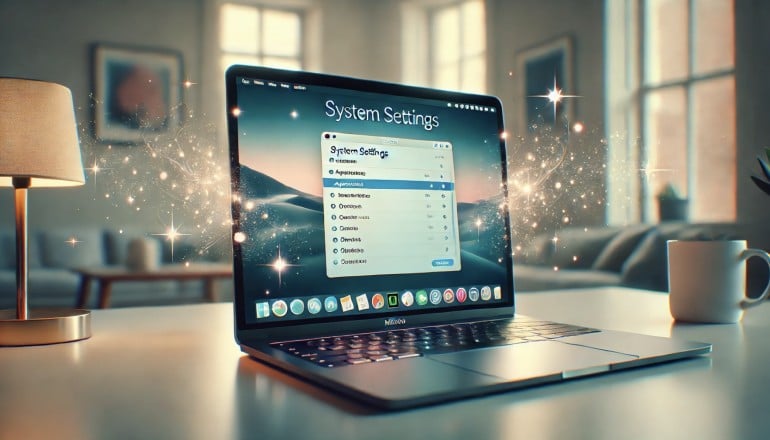
Image generated by Dall-E
Your Mac is more than just a computer — it’s your digital home. Your workspace, creative studio, and productivity hub all rolled into one. While its out-of-the-box experience is impressive, customizing your Mac System Settings can transform it into a finely-tuned instrument that anticipates your needs and works the way you do.
Your machine’s System Settings (formerly called System Preferences) is your Mac’s control center. It’s the central hub where you can configure virtually every aspect of your computer so that it works in a way that feels familiar and intuitive.
Depending on your personal preferences, and perhaps on the kind of work you do, you’ll likely have different needs to those around you. For example, you might hate being interrupted by notifications, beeps and pings. Or maybe you don’t like the way your Mac’s trackpad has been pre-programmed — does it scroll the wrong way? If you regularly edit photographs, you might be selective about the brightness of your display. All of these features can be adjusted to your liking in System Settings.
Here, we’ll explore 17 settings that can help you personalize your Mac. Take the time to make these changes, and you’re likely to work more efficiently and more productively.
Table of Contents
TOC
17 of The Best System Settings: Mac Customization Supercharged
Before we get started, let’s answer two of the most common questions you’re likely to ask if you’re just learning about your Mac’s System Settings.
Where is System Settings on Mac?
Your Mac’s System Settings can be found by clicking the Apple icon in the top-left corner of your screen and selecting “System Settings”, or by clicking the gear icon in your Dock. You can also hit command and spacebar and use your Spotlight feature to search for it.
Remember that if you’re using macOS Ventura or a newer OS, your System Settings will be called “System Settings”. If you’re using macOS Monterey or an older OS, it will be called “System Preferences”.
Why Does My Mac Say System Settings and Not System Preferences?
Longtime Mac users might be more familiar with “System Preferences” than “System Settings”. These two names refer to the same utility. When Apple launched macOS Ventura in October 2022, it changed the name from System Preferences to System Settings. While the app was reworked as part of the upgrade, there are a lot of similarities between the two.
In our guide, we’re going to direct you to the categories used in System Settings. The old System Preferences app has similar categories, but you might need to look in slightly different places. If you’re stuck, you can always search for the setting you’re looking for through the search bar in the top left hand corner.
Right, let’s dive in.
Basic Customizations
We’ve divided our list on Mac System Settings into three categories: basic, intermediate and advanced customizations – so you can tailor your Mac to your workflow and supercharge your user experience. Those listed in this initial list are the settings that every Mac user should know about. They’re small tweaks that will make your Mac feel like your own without much effort at all.
1. Light vs. Dark Mode
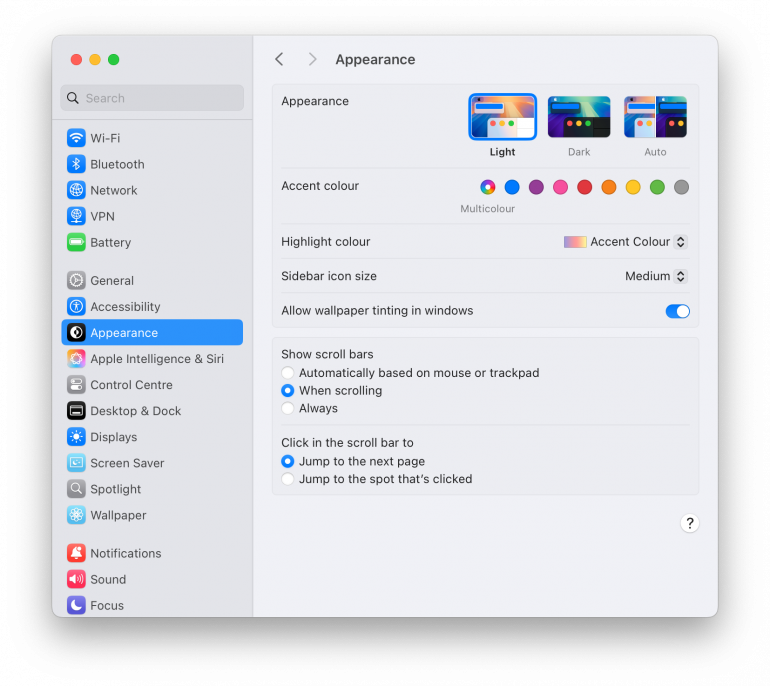
Light and Dark Mode allow you to adjust your screen’s background color for comfort and focus. Light Mode offers better readability in bright environments and maintains the contrast you’re likely familiar with for document work. Dark Mode, on the other hand, uses a darker color scheme that eases eye strain in low-light conditions. It can help to extend the battery life on newer Macs with OLED displays. If you select Auto, your Mac will switch between Light and Dark depending on your Mac’s ambient light sensor readings.
If you head to System Settings > Displays > Night Shift, you can also program your Mac to shift the colors of your display to the warmer end of the spectrum after dark.
Path: System Settings > Appearance
2. Accent Color

If you’re tired of the standard blue that comes as a pre-installed Mac setting, changing the accent color of your Mac is an excellent way to give your machine a personal touch. This splash of color appears in buttons, selection highlights and sidebar icons throughout your system. From a vibrant purple to a lush green, your chosen hue is designed to bring a familiar consistency to your Mac’s visual experience.
Path: System Settings > Appearance > Accent Color
3. Wallpaper and Screen Saver
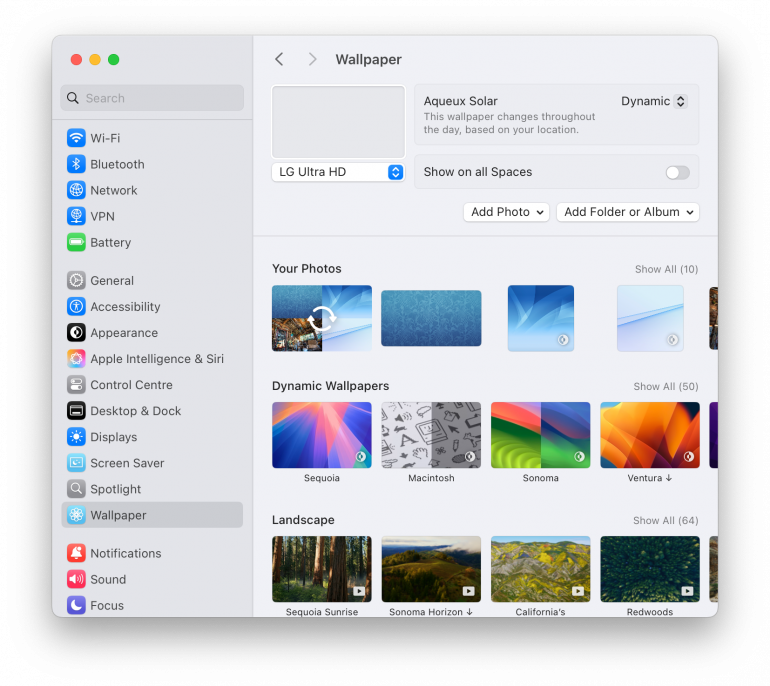
Your wallpaper is the very first image you see when you open your machine, and your screen saver keeps your display occupied when it’s idle. Customizing these images is a quick win that can make your Mac feel truly yours. Choose from Apple’s bold and dynamic collection or add your favourite photos. You can either opt to give your Mac a sleek and professional look or you can use pictures of families and friends to make it more personal and fun.
Path: System Settings > Wallpaper and System Settings > Screen Saver
4. Trackpad
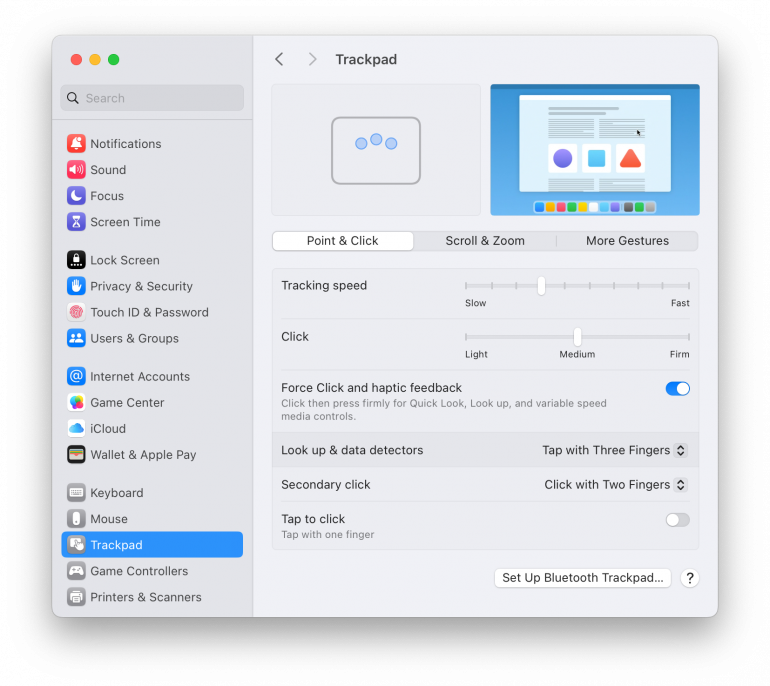
Everyone uses their trackpad in their own way. In fact, it’s often one of the first ways in which someone else’s machine can feel counterintuitive. Program your trackpad exactly the way you like it by tailoring various gestures. From the essential two-finger scroll to the handy three-finger swipe and the location of your secondary click, these movements transform how you interact with your machine. Get them right, and your workflow is likely to feel much more natural and efficient.
Path: System Settings > Trackpad
5. Dock and Menu Bar
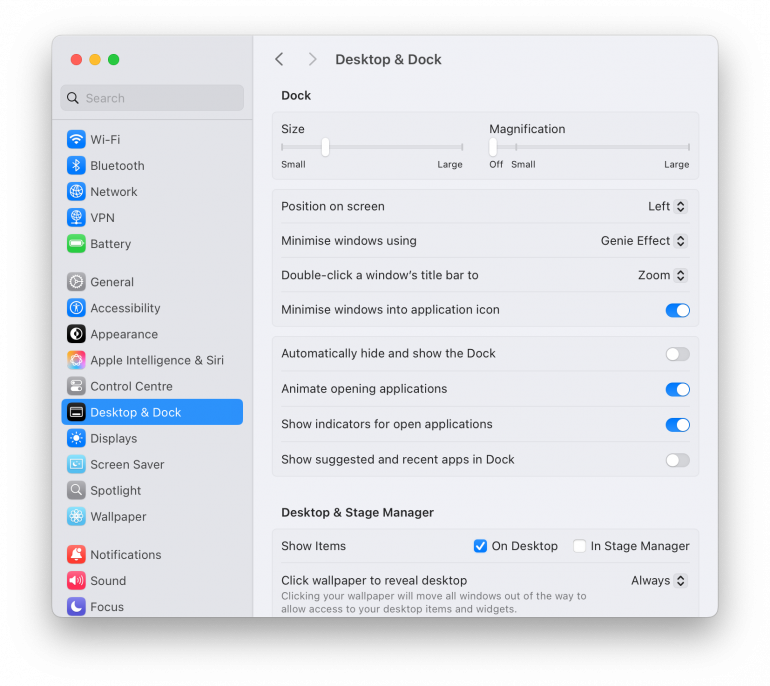
Ask around, and you’ll find that Mac users have strong opinions about how they use their Doc. In this setting, you can adjust your dock size and position. Do you want it on the bottom of your screen or on the side? Should it minimize when not in use or be available always? Do you like it to animate apps as they open or not? You can also customize desktop features like Hot Corners for quick access to Mission Control or the Notification Center. These useful tweaks help to streamline your workflow and keep essential tools within easy reach.
Path: System Settings > Desktop & Dock
Intermediate Customizations
Our second section on intermediate customizations is all about boosting your productivity. Hone your focus, minimize unwanted noise, and balance your screen time with these handy tips.
6. Hot Corners
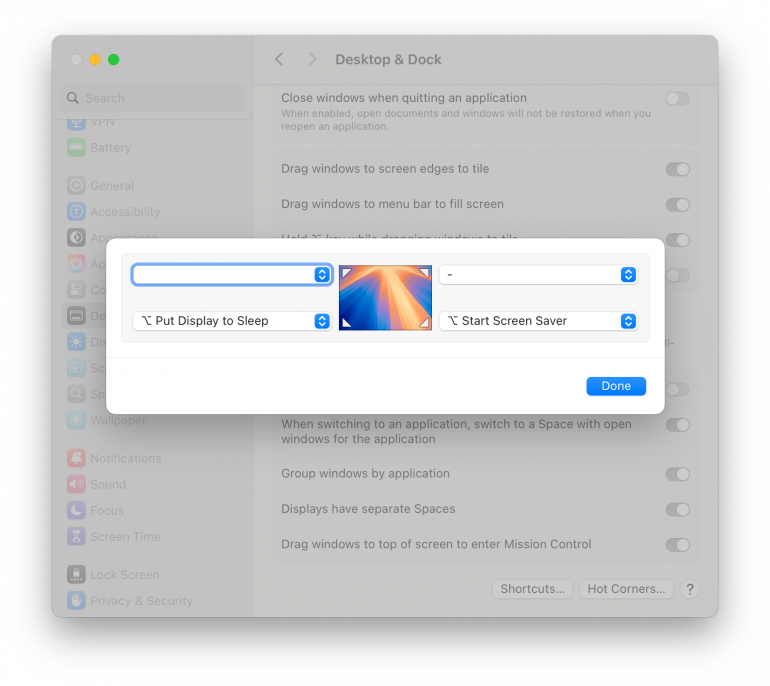
Supercharge your trackpad with Hot Corners, powerful productivity triggers that get you exactly where you need to be — fast. Assign actions like Mission Control, Desktop view, or Screen Saver to each corner. Simply move your cursor to a corner to instantly activate your chosen function, making navigation swift and effortless.
Path: System Settings > Desktop & Dock > Hot Corners
7. Focus
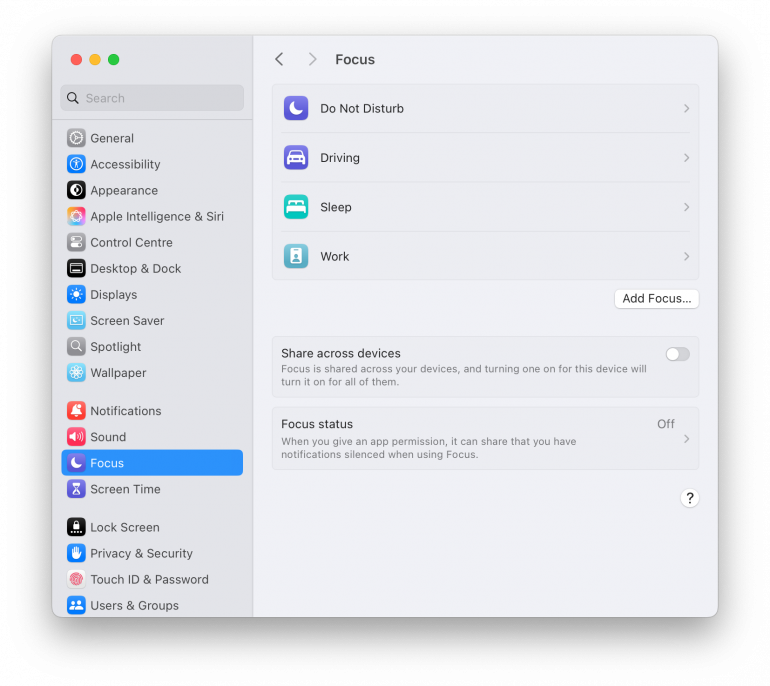
Our digital lives can be non-stop. With global teams working asynchronously, there’s always an email or notification to address. The Focus feature allows you to take control of your digital environment. Create custom modes for work time, personal time or sleep, each with specific notification filters and permitted apps. According to your customizations, your Mac will automatically adapt to your needs, helping you concentrate on what matters most at different times of the day and night.
Path: System Settings > Focus
How to Set Up Focus Mode on Mac
Follow these steps to create and configure your Focus modes:
-
Open System Settings. Go to the Apple menu > System Settings > Focus.
-
Add a New Focus. Click Add Focus. You can choose a preset (Work, Personal, Sleep, Gaming, Do Not Disturb) or create your own using Custom.
-
Customize the Focus. If you selected Custom, give it a name, pick an icon, and choose a color. Or, if you chose a preset, you can customize the icon and color.
-
Choose Allowed Notifications. Decide which people and apps are allowed to notify you. You can also allow Time-Sensitive Notifications so urgent alerts still break through.
-
Set Up Focus Filters. Add Focus Filters to adjust how apps behave while this Focus is active. For example, show or hide specific Mail accounts, Calendar sets, Safari tab groups, or Messages accounts.
-
Adjust Lock Screen & Display Options. Choose whether to dim the Lock Screen, hide notification badges, or show only certain widgets when this Focus is on. (On iOS you can change wallpapers, but on macOS this is limited to behavior.)
-
Configure Automations. Set Focus to turn on automatically by time (e.g., during work hours) or by location (e.g., when you arrive at the office), By app (e.g., when opening Zoom).
-
Enable Additional Options (Optional). Turn on Share Across Devices so your Focus syncs with your iPhone, iPad, and Apple Watch. Then, allow Share Focus Status so contacts know when you have notifications silenced. On supported Macs, enable Reduce Interruptions with Apple Intelligence, which intelligently filters notifications.
-
Save Your Focus. Click Done (where prompted) or close the settings pane and your Focus is saved automatically.
Automation Triggers for Focus Mode on Mac
You can have your Mac automatically enter Focus mode using trigger options. To set it up, navigate to System Settings > Focus, select the Focus mode you want, then scroll to the Set a Schedule section and click Add Schedule. Choose between the options provided:
-
Time-Based Triggers
-
Schedule: Define specific times and days (e.g. 9 AM–12 PM weekdays) for your Focus to turn on automatically.
-
-
Location-Based Triggers
-
Home or Work: Automatically activate a Focus when you arrive at or leave familiar locations.
-
Custom Locations: Choose a coffee shop, co-working space, or any location where you want Focus to switch on.
-
-
App-Based Triggers
-
App: Select one or more apps (e.g., Zoom or Xcode). Your Focus will enable when the app launches and disable when you close it or switch away.
-
Additional Focus Enhancement Tips
-
Share Across Devices: Turn on Share Across Devices, your Focus modes will then sync seamlessly across your iPhone, iPad, Mac, and Apple Watch when using the same Apple ID.
-
Focus Status: Enable Share Focus Status so others (e.g., in Messages) can see that you have silenced notifications. This helps them gauge whether to interrupt or wait.
-
Combine with Screen Time (Manually): Use Focus alongside Screen Time’s tools, like app limits and downtime, to enhance concentration. (Note, you must activate Screen Time restrictions yourself as Focus doesn’t trigger them for you.)
-
Create Multiple Modes: Customize different Focus modes for different tasks, such as Deep Work blocks all nonemergency alerts, Meeting Mode allows only work notifications (e.g., from key contacts or calendar apps), and Creative Time pauses work-related alerts, but allow inspiration apps like Notes or Sketch.
-
Pair with Time Tracking Tools: Tools like Timing help measure how time is spent across apps and tasks. While they don’t automatically connect with Focus mode, using both in tandem enables you to analyze how your Focus settings impact actual productivity.
8. Notifications
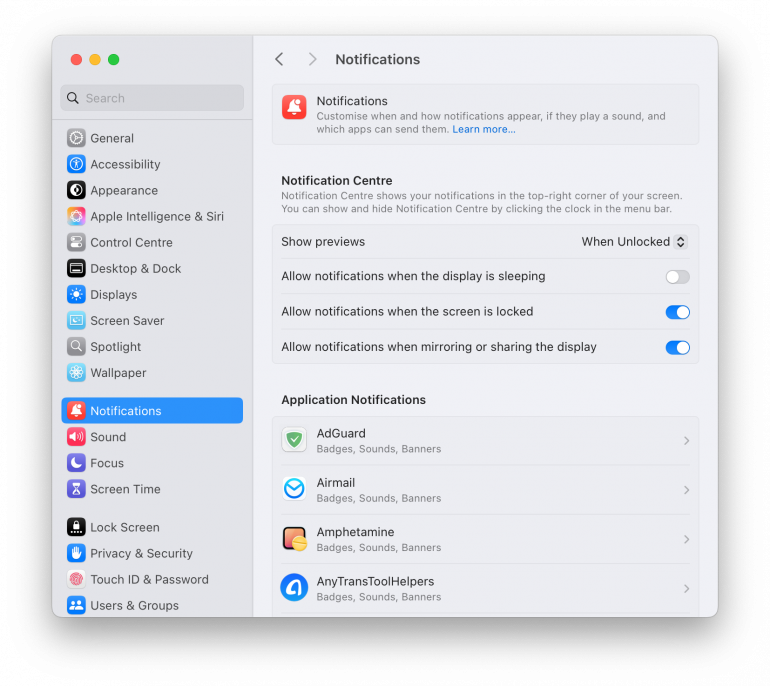
Adjusting your notifications is another way to improve your focus and ensure you don’t get easily distracted by every pop-up and ping. In the Notifications feature, you can fine-tune your alerts app by app, so that you only see the notifications you want to see. Choose between banners, alerts or silent notifications, and decide which apps will appear in your Notification Center.
Path: System Settings > Notifications
9. Sound
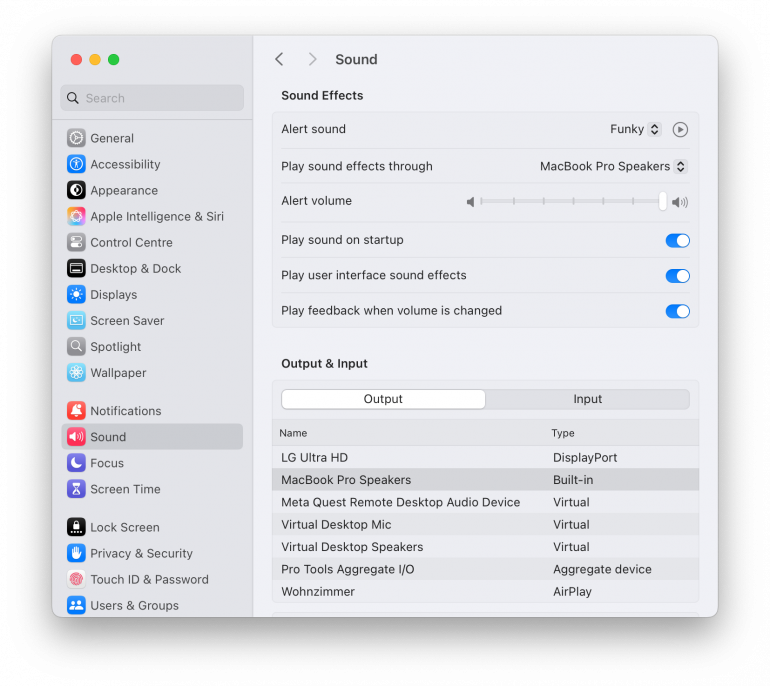
Personalize your Mac’s audio settings by choosing system alert sounds, adjusting input and output settings, and enabling interface feedback sounds. You can even customize the volume levels for different systems events and alerts according to your preferences.
Path: System Settings > Sound
10. Screen Time
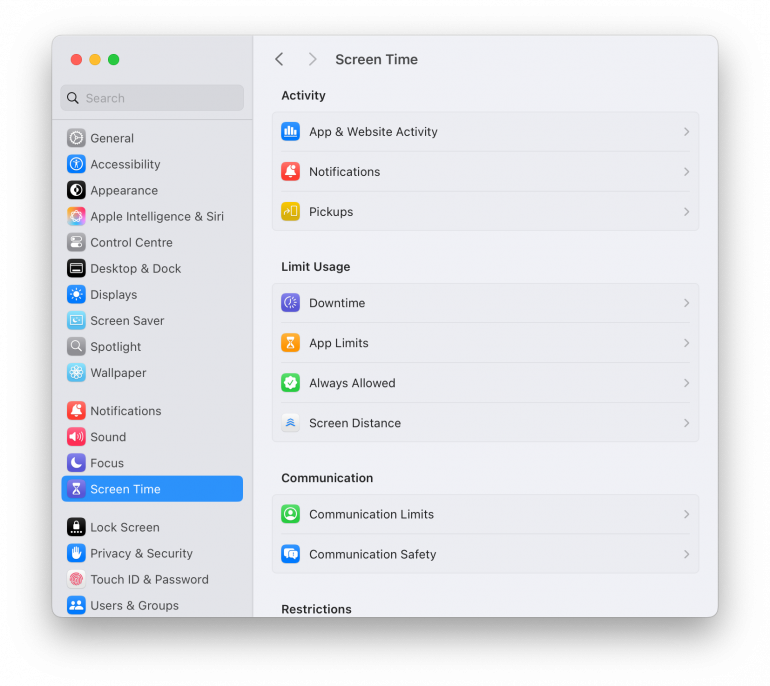
Screen Time is an incredibly useful feature. It tracks and manages your app and website usage across your Apple devices. You can use it to view the time you’ve spent on certain apps and sites, set app or category limits, schedule downtime, restrict content, and generate reports on your usage patterns.
By integrating this tool with an automatic time tracking tool, like Timing, you can see exactly how you spend your time (are there time sinks you should be aware of?) and identify billable hours that might otherwise be missed. Learn more in our complete guide on Screen Time for Mac.
Path: System Settings > Screen Time
Advanced Customizations
If you’re a Mac power user, you likely want to get even more out of your machine. Fine-tuning these features will put you on the path to success.
11. Mission Control
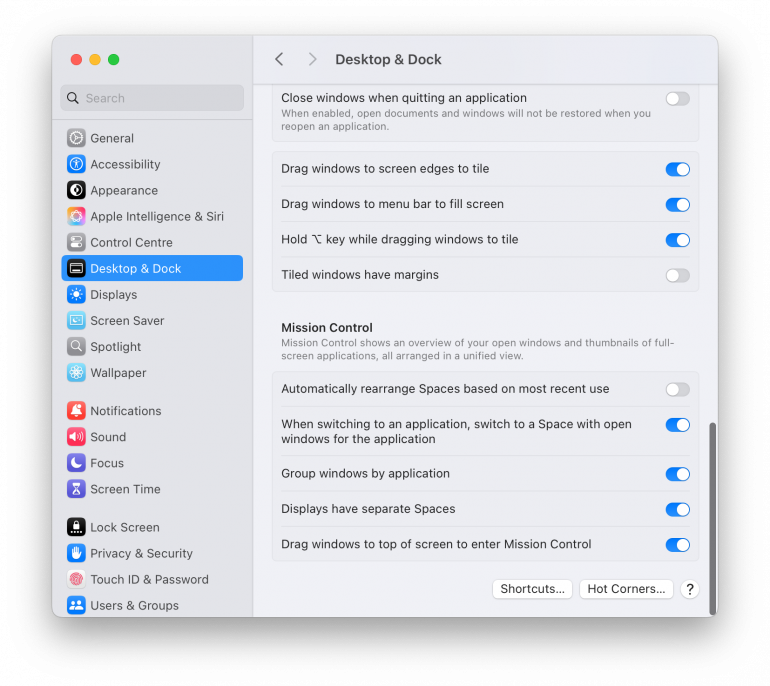
Mission Control offers a bird’s-eye view of your machine, allowing you to manage multiple desktops, open windows, and full-screen apps with ease. If you’re a multitasker (and really, who isn’t?), customizing your Mission Control will help you create separate spaces for different projects and switch between them seamlessly, keeping your work organized and accessible.
Path: System Settings > Desktop & Dock
12. Keyboard Shortcuts
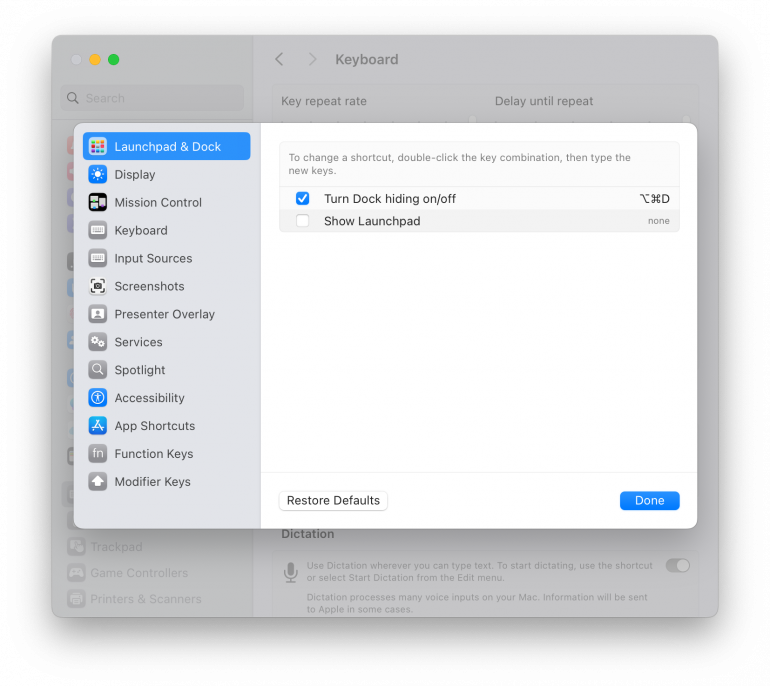
Your keyboard is an incredible productivity tool. By programming intuitive Keyboard Shortcuts, you can create custom combinations for frequently used commands, system functions, or specific apps. These personalized shortcuts can save you countless clicks and significantly speed up your daily tasks. Get the lowdown on the best Mac Keyboard Shortcuts here.
Path: System Settings > Keyboard > Keyboard Shortcuts
13. Energy Saver Settings
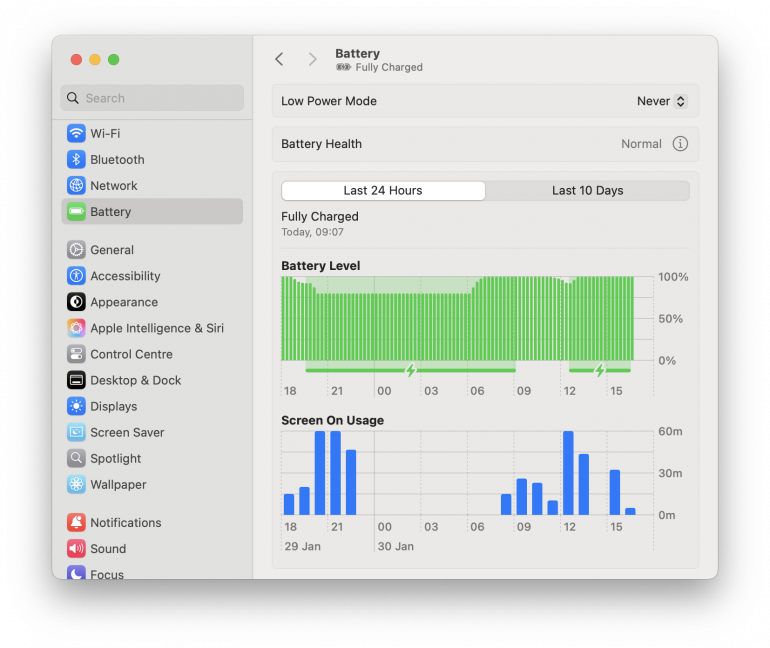
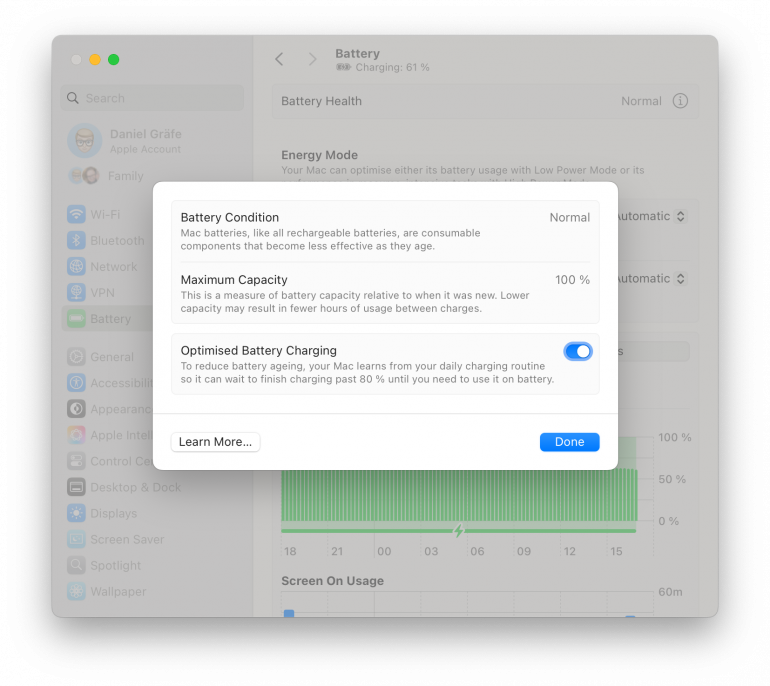
Optimize your Mac’s power consumption by configuring your sleep settings, enabling Power Nap for background updates, and balancing your performance with your battery life. Remember that it’s also worth optimizing your battery charging by clicking on the “i” next to “Battery Health” and toggling on “Optimised Battery Charging”. This keeps your battery at 80% to help to reduce how quickly your battery ages. These settings help extend your battery’s longevity while ensuring that your machine performs efficiently.
Path: System Settings > Battery
14. Accessibility Options
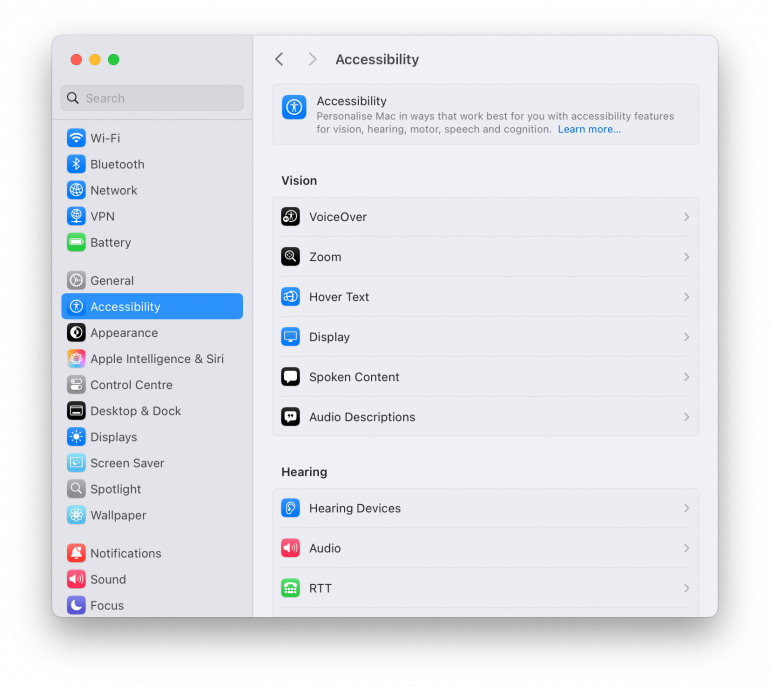
Looking for ways to make your Mac more accessible to your needs? Your machine has a number of accessibility options, including vision, hearing, motor, and speech settings. These powerful features ensure your Mac works exactly to your requirements. Take a look for the hidden gems that allow you to use voice commands, add color filters, and zoom your screen with ease.
Path: System Settings > Accessibility
15. App Launch Automations
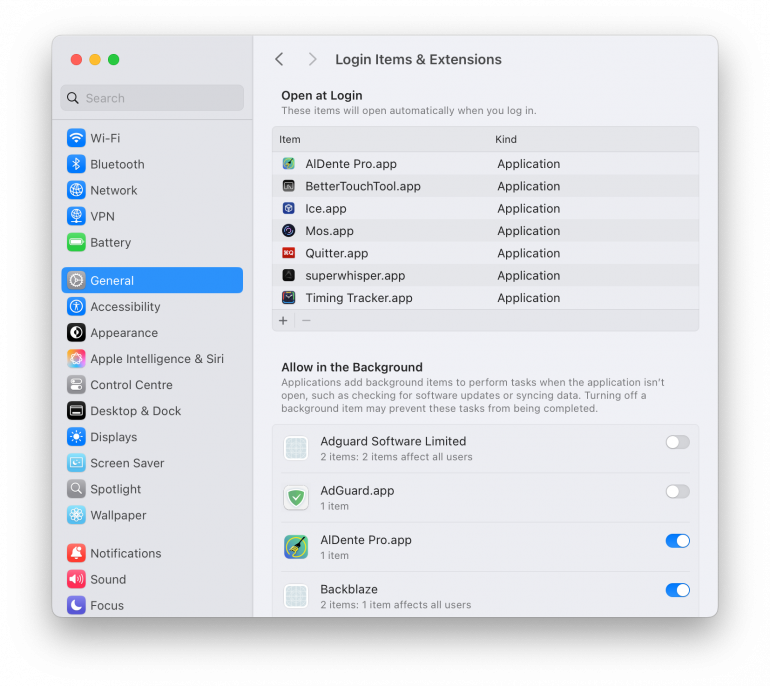
If there are apps you’re likely to use the moment you start up your machine, you can program them to launch automatically every time. Under Login Items, simply choose which apps should start when your Mac boots up so that you don’t waste valuable time searching for them.
Path: System Settings > General > Login Items
16. Custom Keyboard Dictation
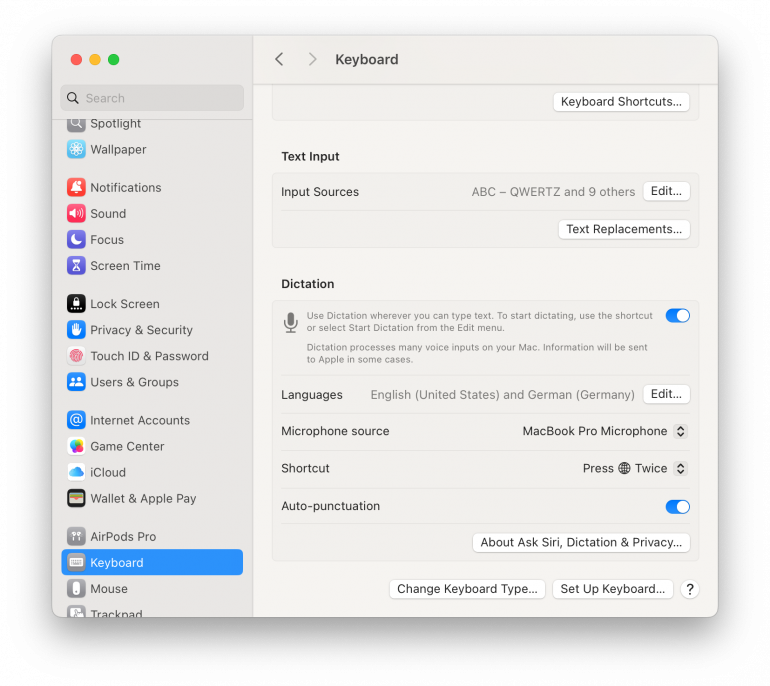
Transform your thoughts into text effortlessly using the Dictation function. Enable advanced dictation features, customize voice commands, and teach your Mac to recognize your speech patterns for improved accuracy. With this simple change, you can dramatically improve your workflow with hands-free typing.
Path: System Settings > Keyboard > Dictation
17. Finder Settings
Did you know that you can unlock your Finder’s full potential through its settings? In your Finder (rather than System Settings), you can adjust several settings to display file paths, hard drives and tags. By changing how you display hard drives on your Finder, you can make them accessible both on your desktop and through the Finder sidebar. And by applying tags, you can quickly access items that fit a particular description, making your file navigation and organization seamless. Curious to find out more? This handy video features some useful tips on configuring your Finder, your way.
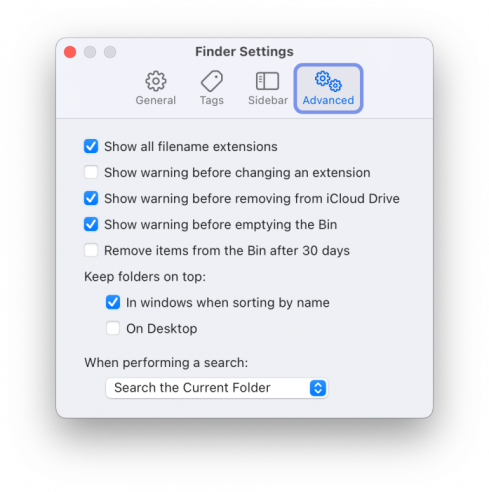
Mac System Settings: Bonus Tips and Recommendations
Still looking for ways to make your Mac your own?
Consider looking at your Privacy & Security settings. Are you happy with the permissions you’ve granted to certain apps? Go through the list carefully so that you can ensure your online privacy is properly protected. You might also want to take a look at our guide on trusting SaaS products with your data before you give away valuable information.
And finally, consider integrating Timing with these settings so that you know how these customizations impact your productivity.
For example, seeing how much your productivity increases when you minimize your notifications and fine-tune your focus might encourage you to change your work schedule slightly. If you notice that you work more efficiently in the mornings, you could time block your diary so that you’re able to work uninterrupted. Timing’s Stats tab indicates exactly which times of the day, and which days of the week, you’re most productive, which can help to guide your decision-making.
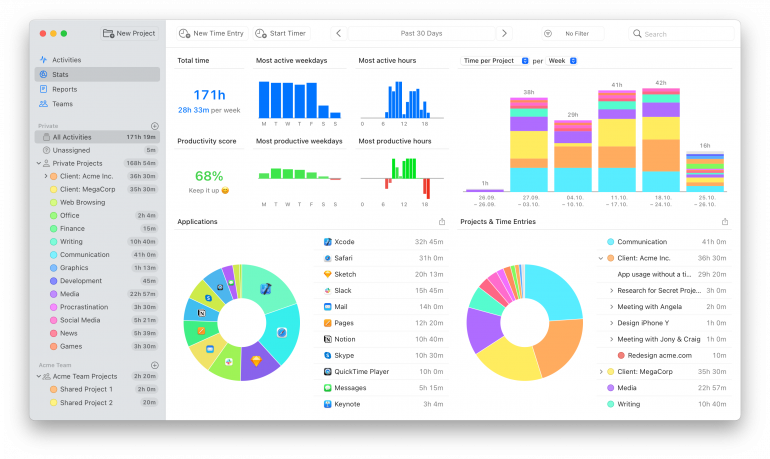
The Final Word on Your Mac’s System Settings
Customizing your Mac’s System Settings amounts to more than just aesthetic tweaking. It’s about creating a workspace that makes your digital life more familiar and enjoyable and, most importantly of all, enhances your productivity. From basic display adjustments to advanced automation features, each setting you personalize brings you closer to a truly optimized workflow.
While these 17 settings provide an excellent foundation, the real power comes from combining them with productivity tools that help you understand and improve your work patterns. By pairing your custom features with Timing, for example, you can gain valuable insight into how these personalizations affect your productivity.
Ready to take your Mac usage to the next level? Download Timing’s free 30-day trial and discover how these custom settings translate into real focus, productivity and efficiency gains.
